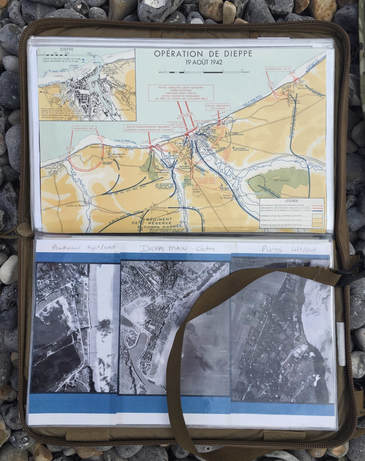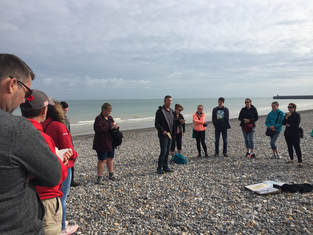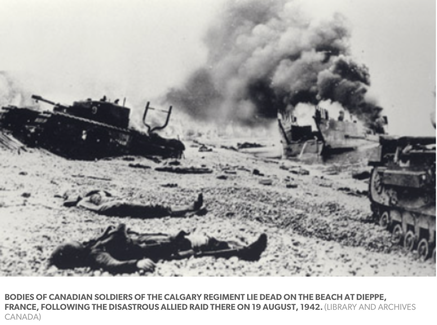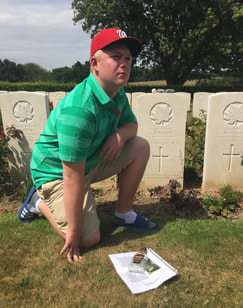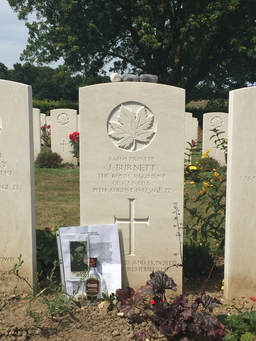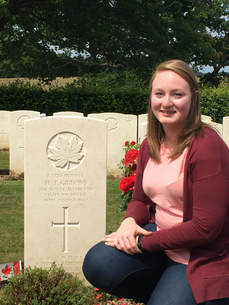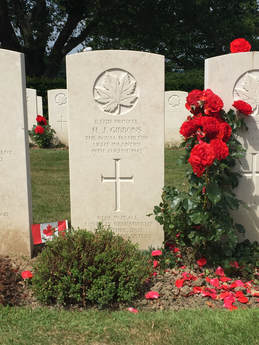"Why do we spend so much time on the Dieppe Raid in our History classes when it lasted only 8 hours?"
Today's Itinerary and Activities
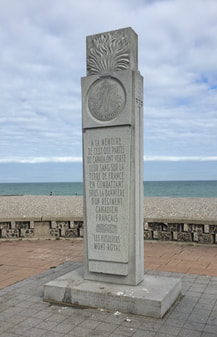 The Dieppe Memorial commemorates the French Canadian regiment Mont-Royal Fusiliers
The Dieppe Memorial commemorates the French Canadian regiment Mont-Royal Fusiliers
Today we gained a deeper understanding of the August 1942 Dieppe Raid. Specifically, we challenged the dominant narrative of the raid and discussed how best to address the raid in our classrooms.
We began the day on Dieppe's beach. After each of us shared a word that we feel captures the essence of Dieppe, Lee shared some information about the raid and Cindy had us consider the impact of the assault on civilians. This led into a discussion about whether the assault on Dieppe was necessary. Following the discussion of military necessity, Blake explained some of the pitfalls teachers and students face when they study the assault on Dieppe. Before leaving the beach, Blake and Lee led some participants through a Tactical Exercise Without Troops (TEWT).
After completing our discussion about the Dieppe Raid, we visited - and some of us purchased French delicacies - at the Dieppe Market. Following this, we packed our kit into the vans and drove to the Dieppe Canadian War Cemetery where Abbi and Marshall shared the lives of the soldiers they researched. Before leaving the cemetery, Abbi facilitated a seminar during which we discussed how to teach students about the Dieppe Raid.
After lunch, we drove southwest to Bayeux, which is located in the Calvados region of Normandy. Upon arriving there, we picked up groceries and then drove to and settled into the Moulin Morin, our home base for the next six nights.
We began the day on Dieppe's beach. After each of us shared a word that we feel captures the essence of Dieppe, Lee shared some information about the raid and Cindy had us consider the impact of the assault on civilians. This led into a discussion about whether the assault on Dieppe was necessary. Following the discussion of military necessity, Blake explained some of the pitfalls teachers and students face when they study the assault on Dieppe. Before leaving the beach, Blake and Lee led some participants through a Tactical Exercise Without Troops (TEWT).
After completing our discussion about the Dieppe Raid, we visited - and some of us purchased French delicacies - at the Dieppe Market. Following this, we packed our kit into the vans and drove to the Dieppe Canadian War Cemetery where Abbi and Marshall shared the lives of the soldiers they researched. Before leaving the cemetery, Abbi facilitated a seminar during which we discussed how to teach students about the Dieppe Raid.
After lunch, we drove southwest to Bayeux, which is located in the Calvados region of Normandy. Upon arriving there, we picked up groceries and then drove to and settled into the Moulin Morin, our home base for the next six nights.
Important Points to Consider About the 19 August 1942 Dieppe Raid
|
To begin the discussion about the August 1942 Dieppe Raid, we each shared a word that comes to mind when we think of Dieppe. The following were the words contributed: Monumental, controversial, necessary, challenging, unlucky, harsh, sad, rocky, ambitious, failure, forgetful, and enigma.
After this opening activity, Lee described what he considers to be key aspects of the assault on Dieppe: The central debate surrounding the purpose of the Dieppe Raid concerns how the Allies could assist the Soviets in 1942. Nevertheless, Canadian histories of the raid typically focus more on the operational and tactical planning and execution of the raid rather than on the raid's strategic international purpose. Internationally, the Second Moscow Conference took place in the days leading up to the raid (12-17 August 1942). During the conference, British Prime Minister Winston Churchill, the United States' Special Representative W. Averell Harriman, and the Soviet Union's Premier Joseph Stalin discussed grand strategy and planned future campaigns. While these |
leaders were in meetings, German Armies were driving deep into the Soviet Union towards the Caucuses oilfields, south of Stalingrad.
The Canadians who landed at Dieppe knew the tactical and operational purposes of the Dieppe Raid. In other words, they knew their purpose and function during the assault at Dieppe and they understood how their actions fit into the joint air, sea, and land mission. However, the Canadian units that landed at Dieppe did not know the exact strategic and geo-political purposes of the assault, because if these purposes had ever been unveiled to the Germans, the effects would have been devastating. Nevertheless, at the time, there was much talk in the Western world, including in the newspapers, about the need to open a second front and take other action to assist the Soviets.
The Dieppe Raid was intentional on different levels:
The YouTube videos below provide further insights into the August 1942 Dieppe Raid. Throughout this two-part video series, Dr. Terry Copp, one of Canada's leading military historians, provides in-depth information and poses thought-provoking questions about the assault on Dieppe.
The Canadians who landed at Dieppe knew the tactical and operational purposes of the Dieppe Raid. In other words, they knew their purpose and function during the assault at Dieppe and they understood how their actions fit into the joint air, sea, and land mission. However, the Canadian units that landed at Dieppe did not know the exact strategic and geo-political purposes of the assault, because if these purposes had ever been unveiled to the Germans, the effects would have been devastating. Nevertheless, at the time, there was much talk in the Western world, including in the newspapers, about the need to open a second front and take other action to assist the Soviets.
The Dieppe Raid was intentional on different levels:
- Soldiers' Intent: The Canadian soldiers' intent was to get ashore, test weapons and tactics, kill some of the enemy, and destroy some of the enemy's equipment. Another objective of the soldiers was to demonstrate to the people of France that the Allies were able to and were going to return to France.
- Strategic Intent: The Dieppe Raid was designed to test plans for a later full-scale invasion. As such, the Allies' strategic intent was to mount a show of force and get a full infantry division with tanks ashore to see how the Germans would react (with counter-attack reserves).
- Political Intent: The political intent of the raid was to render meaningful assistance to the Soviets by diverting German attention to reinforcing the Atlantic Wall defences. The raid was also intended to demonstrate to the United States - a new partner - that a full-scale invasion of France in 1942 was not possible. The Allies needed to buy time to build their forces and win the Battle of the Atlantic before they could land in Europe to stay. The Dieppe Raid was also mounted with the knowledge that American and British forces would land in French North Africa before the end of 1942, putting an end to Vichy France and building a base to grow the Free French Forces of the Interior.
The YouTube videos below provide further insights into the August 1942 Dieppe Raid. Throughout this two-part video series, Dr. Terry Copp, one of Canada's leading military historians, provides in-depth information and poses thought-provoking questions about the assault on Dieppe.
|
|
|
Was the Dieppe Raid a Military Necessity?
After gaining some background knowledge about the Dieppe Raid, we brainstormed the following reasons for and against the raid:
|
The Dieppe Raid Was Necessary
|
The Dieppe Raid Was Not Necessary
|
Why does the Dieppe Raid receive so much attention in History curricula?
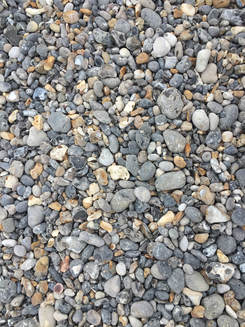 Dieppe's beach is rocky
Dieppe's beach is rocky
Despite the fact that the Dieppe Raid lasted only eight hours, it makes its way into History textbooks and other secondary sources. Abbi, Janelle, and Kathryn shared their thoughts as to why this might be:
- Abbi: "The narrative that is prominent in regards to the Dieppe Raid is a dramatized and sexy version of the reality. This dramatic story of a failed mission provides a perspective that sells history."
- Janelle: "I think that the Dieppe raid was necessary as a part of the Second World War. I think that it showed the German military that the Allied armies could bring in enough force to overcome their army. It was also important because it was a way for the Allies to find out what types of troops and fire power the German army would have later on in the war during the Normandy Campaign."
- Kathryn: "We revel in the victim narrative ... why? We need to examine why we revel in the victim narrative. Why do we not promote our contributions to the greater war effort?"
Presentism
While on Dieppe's beach, Blake explained that presentism is the practice of thinking about an event from a hindsight point of view. He advised that when thinking historically, it is important to refrain from practising presentism. He went on to suggest that to avoid presentism, teachers and students must consider the political, economic, and social situation during the period that the event took place. Studying primary source evidence helps teachers and students understand historical events in context.
Teaching the Dieppe Raid
Blake asked us to consider the purpose of teaching the Dieppe Raid. He then drew our attention to some challenges that teachers face when teaching their students about the Dieppe Raid. He went a step further to explain how teachers can enable students to think critically and historically about the raid.
|
Challenges
|
Solutions
|
Using Evidence Versus Manipulating Evidence
|
During our discussion about teaching the Dieppe Raid, Cindy and Blake showed us the photograph to the left, explaining that it is one of the most commonly used images in History textbooks. They then brought to our attention the fact that there exists no evidence to suggest that the photograph provides an accurate narrative of what happened at Dieppe on 19 August 19 1942. In fact, Cindy and Blake shocked many of us when they informed us that the image was taken and manipulated by the Germans in their effort to spread propaganda.
This photo lends itself to a possible research question for students: If the Canadians did not all die at once, what actually did happen during the Dieppe Raid?. |
Tactical Exercise Without Troops: An Authentic Learning Activity
|
To enhance our understanding of the conditions that the Canadian troops faced when they came ashore at Dieppe, Blake and Lee led many participants through a Tactical Exercise Without Troops (TEWT). This exercise involved the participants charging from the water's edge, up the rocky beach towards the town.
After completing the exercise, many participants commented on the challenges that the Canadian troops must have faced during the raid. They observed that it would have been very difficult for the Canadians to move efficiently up the beach's steep slope over slippery and uneven chert rock, all the while carrying heavy kit. |
|
Soldier Biographies
Marshall's Soldier
Private James Burnett
Royal Regiment of Canada, R.C.I.C.
Dieppe Canadian War Cemetery
Private James Burnett
Royal Regiment of Canada, R.C.I.C.
Dieppe Canadian War Cemetery
Abbi's Soldier
Private Harry James Gibbons
Royal Hamilton Light Infantry, R.C.I.C.
Dieppe Canadian War Cemetery
Private Harry James Gibbons
Royal Hamilton Light Infantry, R.C.I.C.
Dieppe Canadian War Cemetery
Seminar
After Abbi and Marshall's soldier biographies, Abbi led a large group discussion during which we pondered and shared responses to the following questions:
- How did you approach the topic of Dieppe in your classroom prior to participating in this morning's discussion and TEWT activity?
- Do you think your teaching method with change? How will you teach students about the Dieppe Raid now?
